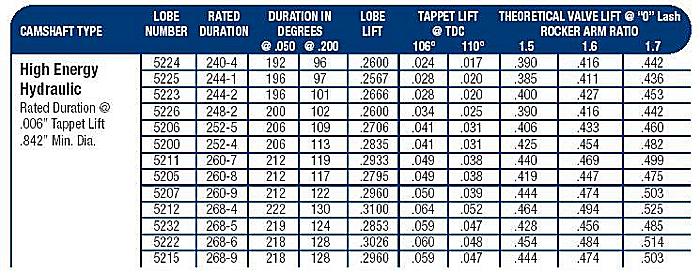Cam Specs
Tech Question
Jon Mickley, Haughton, LA, USA, 1972 Plymouth Road Runner 440
I have a question regarding camshaft specifications.
I’m rebuilding the stock 440 (high perf 4BBL). Having it bored .030 dueto cylinder wear, and planning on putting a Holly Street Avenger 670 CFMcarb, aluminum manifold, and new cam it in.
As I look at the specifications for cams I notice some list the durationwith the annotation “@ .050”. The specs for the cam in the engine,according to the factory service manual engine specs are as follows:
Intake Opens (BTC) 21 degrees
Intake Closes (ABC) 67 degrees
Exhaust Opens (BBC) 79 degrees
Exhaust Closes (ATC) 25 degrees
Valve Overlap 46 degrees
Intake Valve Duration 268 degrees
Exhaust Valve Duration 284 degrees
Intake Lift (zero lash) .450 inch
Exhaust Lift (zero lash) .464 inch
I’m trying to figure out how the durations listed in the specs equate toones that have the “@.050″ annotation.
Additionally I’m trying to figure out just how much additional lift I canhandle before encountering valve/piston clearance, or valve springcompression problems.
I plan to drive the car on the street, but not race it, so I’m notinterested in getting too wild with the engine modifications.
Thanks in advance for any help you might be able to give me.
Jon-
This is actually a very complex topic.
All OEM cams, as well as MP’s offerings, are measured and rated using SAEprocedures, which calls for measuring duration, in crankshaft degrees,from/to 0.006” valve lift. This results in the common “advertised duration”that you see in factory catalogs, service manuals, etc., as is the case foryour cam which sounds like the immensely popular – but outdated – stock3838/440 Magnum grind.
But, as camshafts became “wilder”, the California grinders began to realizethat the true “area under the curve” – which, to a fairly large extent,determines how much HP an engine can make, can be more accuratelydemonstrated by looking at the duration from/to 0.050″ lift. By 0.050″, the”shape” or aggressiveness of the lobe has made itself known. So they decidedto use duration @ 0.050″, which, of course, results in a lower number. Asyou can see in the chart from Comp Cams’ latest catalog attatched, there’s aworld of difference between the numbers. But, depending on the lobe’s rateof lift, this difference isn’t linear or uniform, so, despite what you mayhave read, there can be no accurate conversion factor to go from one numberto the other.
As roller cams, and fast-ramp flat tappet cams designed for the “Chrysleradvantage” – the large 0.904″ lifters – have begun to proliferate, even the0.050″ number becomes less significant. You also need to know the durationat 0.100, 0.150, 0.200…etc. In other words, you need to see the whole camplot and a calculation of the area under the curve. Most engine builders nowhave a cam checker device that can do just that, even superimposing thegraph of you old and potential-new cams on the same sheet. Then you canvisually compare the overlap, lift, duration, etc., and hopefully, make aninformed decision about which cam you need.
However, it takes years of experience, dyno runs, etc., to get this right.That’s why, for most of us, either on of the popular cam-picking computerprograms, or a call to a cam grinder’s tech line, is usually the best plan.At any rate that tech line should be able to give you duration at 0.006″ and0.050″ for any cam they manufacture. It is possible to get a cam withdead-stock advertised duration, lift, and overlap, and yet mke a LOT moreHP!
Unless the cam you choose is very, very little changed from stock, you mustcheck for coil bind and V-P clearance. Or pay the price later.
Rick



Comments are closed.